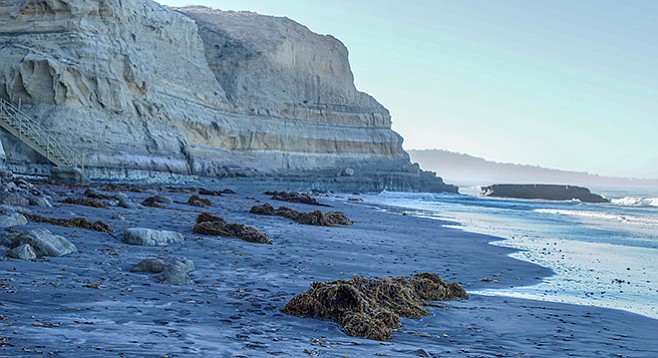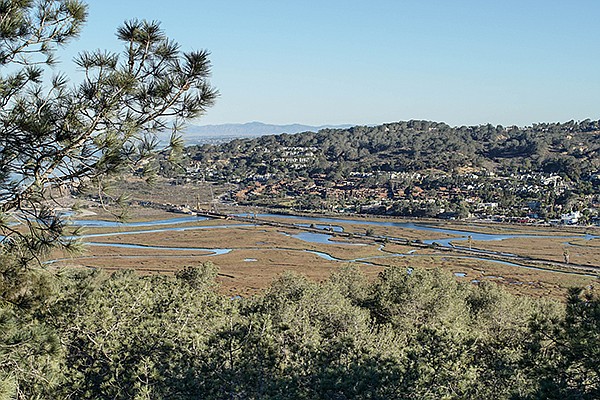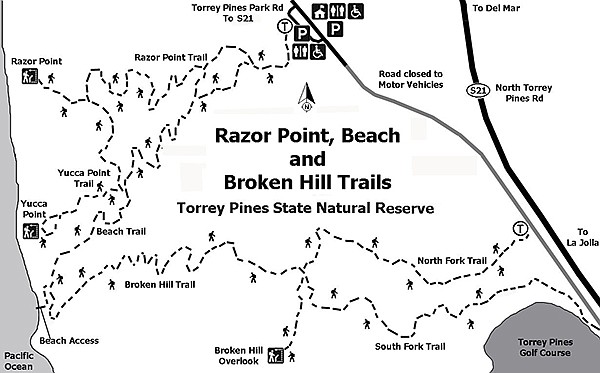 Facebook
Facebook
 X
X
 Instagram
Instagram
 TikTok
TikTok
 Youtube
Youtube

Established to protect the life forms found within it, the Torrey Pines State Natural Reserve became an official state park in 1956. Found within its borders is the Torrey pine (Pinus torreyana), the rarest pine in North America. The Torrey pine’s native habitat is restricted to the Del Mar area and to Santa Rosa Island. The species itself is unusual, not only for its limited distribution, but also because — though it is a yellow pine similar to Jeffrey and ponderosa pines — its needles occur in bunches of five rather than three, as is found in its relatives.
The Beach Trail is a very popular reserve trail. Runners and fitness walkers like it because it provides a great aerobic workout. Hikers and naturalists enjoy it for its ocean views and the opportunity to explore the rich natural history. The Beach Trail starts across the street from the Lodge at Torrey Pines, on the north side of the restrooms.
The trail is well maintained and signed so you won’t get lost. It passes many Torrey pines, but keep an eye open for the other interesting plants that grow within the park, particularly in the spring when small annual wildflowers are in bloom.

Winding your way along the trail will take you through coastal sage scrub habitat and down more than 186 steps, eventually leading to a narrow eroded gulch with a stairwell carved from sandstone, marking the final descent to the beach. Caution is necessary in the rainy season, as the steps can be very slippery when wet.
The final stairwell, leading down from the bluffs, takes visitors to Flat Rock Beach, where you can see and climb on the large multi-colored slab that is the beach’s namesake. Millions of years ago, coastal San Diego looked much like the current eastern shoreline of the U.S., mostly flat with barrier islands a few miles off shore.
These islands were composed of sand piled up on a shallow seabed by wave action. Lagoons formed between the barrier islands and the low continental shore where mud, silt, and sand accumulated. Combined with the movement of tectonic plates, the sediments resulted in the formation of a fossil-rich layer of yellow-greenish mudstone rock. Flat Rock is a fragment of this mudstone and is embedded with fossil clam and oyster shells that are easily seen at low tide. Finding the fossils is a great treat for kids while exploring the rock.

Sand and surf guide visitors back north to the park entrance. If you are lucky, you might find seals resting on the boulders around Flat Rock. Visitors looking for a longer hike should head back up the road to the lodge and begin a new descent back down the sage-scrub slopes or take one of the other trails found within the reserve.
Distance from downtown San Diego: approximately 17 miles. Allow 30 minutes driving time (La Jolla). From I-5, go west on Carmel Valley Road for 1.6 miles. Turn left on South Camino Del Mar, which becomes North Torrey Pines Road as you cross into La Jolla. Go 0.9 mile to the park entrance to pay a day-use fee, and then turn left and park in the lot. The parking area has facilities; however, there are no facilities along the trail except near the lodge at the top of the hill.
Hiking length: 1.5 miles out and back.
Difficulty: Moderate due to the elevation gain along the trail and erosion in some areas. The overall elevation gain/loss is about 340 feet. Dogs are not allowed within the reserve or on the beach.
Along the beach, sandstone cliffs tower above the shore. High tides and storm waves break at the foot of the cliff, undermining the soft sandstone and leaving boulders at the foot of the cliffs. The multi-colored sandstone, which looks like a gigantic layered cake, is unstable. The large boulders scattered along the shore serve as a reminder that visitors need to be cautious and stay off the cliffs.


Established to protect the life forms found within it, the Torrey Pines State Natural Reserve became an official state park in 1956. Found within its borders is the Torrey pine (Pinus torreyana), the rarest pine in North America. The Torrey pine’s native habitat is restricted to the Del Mar area and to Santa Rosa Island. The species itself is unusual, not only for its limited distribution, but also because — though it is a yellow pine similar to Jeffrey and ponderosa pines — its needles occur in bunches of five rather than three, as is found in its relatives.
The Beach Trail is a very popular reserve trail. Runners and fitness walkers like it because it provides a great aerobic workout. Hikers and naturalists enjoy it for its ocean views and the opportunity to explore the rich natural history. The Beach Trail starts across the street from the Lodge at Torrey Pines, on the north side of the restrooms.
The trail is well maintained and signed so you won’t get lost. It passes many Torrey pines, but keep an eye open for the other interesting plants that grow within the park, particularly in the spring when small annual wildflowers are in bloom.

Winding your way along the trail will take you through coastal sage scrub habitat and down more than 186 steps, eventually leading to a narrow eroded gulch with a stairwell carved from sandstone, marking the final descent to the beach. Caution is necessary in the rainy season, as the steps can be very slippery when wet.
The final stairwell, leading down from the bluffs, takes visitors to Flat Rock Beach, where you can see and climb on the large multi-colored slab that is the beach’s namesake. Millions of years ago, coastal San Diego looked much like the current eastern shoreline of the U.S., mostly flat with barrier islands a few miles off shore.
These islands were composed of sand piled up on a shallow seabed by wave action. Lagoons formed between the barrier islands and the low continental shore where mud, silt, and sand accumulated. Combined with the movement of tectonic plates, the sediments resulted in the formation of a fossil-rich layer of yellow-greenish mudstone rock. Flat Rock is a fragment of this mudstone and is embedded with fossil clam and oyster shells that are easily seen at low tide. Finding the fossils is a great treat for kids while exploring the rock.

Sand and surf guide visitors back north to the park entrance. If you are lucky, you might find seals resting on the boulders around Flat Rock. Visitors looking for a longer hike should head back up the road to the lodge and begin a new descent back down the sage-scrub slopes or take one of the other trails found within the reserve.
Distance from downtown San Diego: approximately 17 miles. Allow 30 minutes driving time (La Jolla). From I-5, go west on Carmel Valley Road for 1.6 miles. Turn left on South Camino Del Mar, which becomes North Torrey Pines Road as you cross into La Jolla. Go 0.9 mile to the park entrance to pay a day-use fee, and then turn left and park in the lot. The parking area has facilities; however, there are no facilities along the trail except near the lodge at the top of the hill.
Hiking length: 1.5 miles out and back.
Difficulty: Moderate due to the elevation gain along the trail and erosion in some areas. The overall elevation gain/loss is about 340 feet. Dogs are not allowed within the reserve or on the beach.
Along the beach, sandstone cliffs tower above the shore. High tides and storm waves break at the foot of the cliff, undermining the soft sandstone and leaving boulders at the foot of the cliffs. The multi-colored sandstone, which looks like a gigantic layered cake, is unstable. The large boulders scattered along the shore serve as a reminder that visitors need to be cautious and stay off the cliffs.
Comments